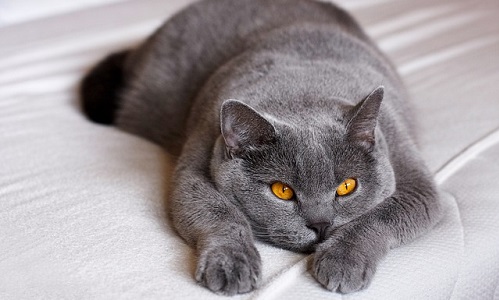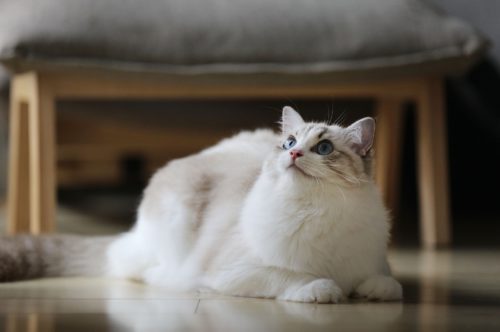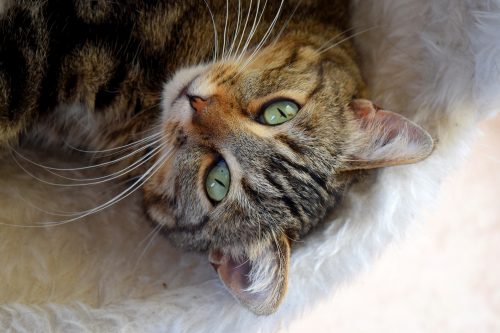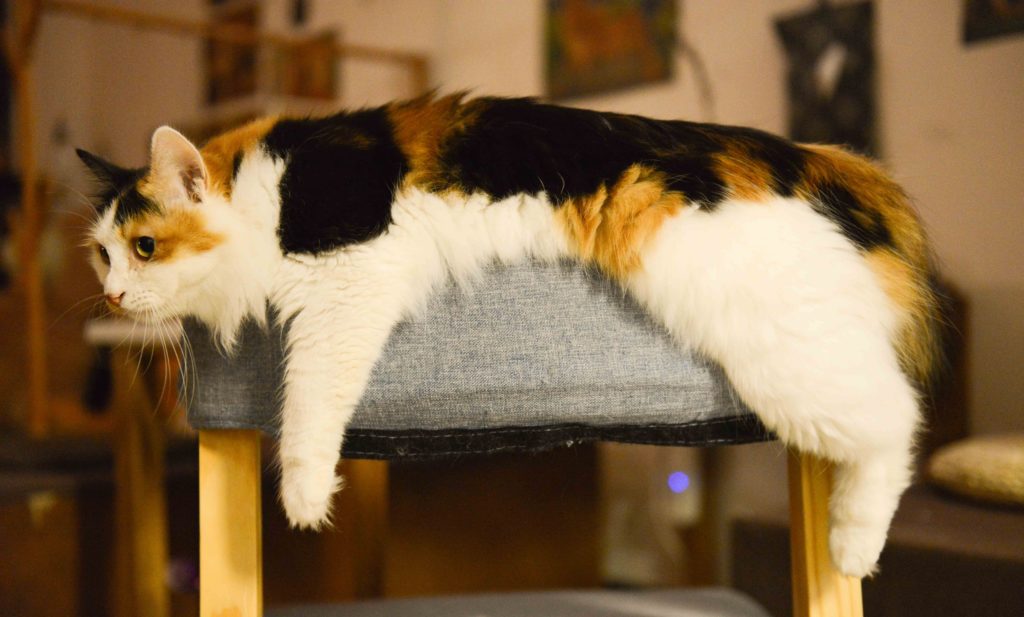You’ve noticed that your furry friend has packed on a few extra pounds. At first, it wasn’t cause for concern, but then you realize he’s struggling to jump and climb like he used to. Then you wonder, “Is my cat overweight?”.
While healthy cats can come in a variety of different sizes, obesity and weight gain are common issues with felines. The Association for Pet Obesity Prevention (APOP) estimates that 60 percent of cats in the United States are overweight.
Trying to figure out if your cat is overweight is a little more complicated than just stepping onto a bathroom scale. There is no exact “right” weight for your cat; the “normal” weight for cats can be anywhere from 7 to 15 pounds, depending on the breed and body type. On average though, a medium or small cat should weigh 7 to 13 pounds and a large cat may be between 13 and 24 pounds.
Environmental factors, like overfeeding and lack of exercise, are usually the most common causes of cat weight gain. Cat owners will tend to “free feed” their pet (giving them access to food at all times), and will often spoil them with treats. Domesticated indoor cats do not typically get as much exercise as outdoor cats, this might be due to a lack of stimulation or entertaining toys. Cats who are antisocial or afraid of strangers might spend more time hiding than being active as well.
However, environmental factors are not always the cause. Medications, diseases, and medical conditions may also cause your cat to gain weight. And, as cats get older, their metabolism slows and their activity levels decrease. The nutritional needs of an older cat is different than younger cats, if you do not change the amount or type of food you give your cat as he ages, that can also lead to weight gain.
Excess weight and feline obesity can cause or exacerbate other health problems, so it’s important to take your cat to the vet if you notice he has gained weight. Taking action to slow or reverse your cat’s weight gain will better his quality of life and keep him around as your companion for much longer.
Recognizing that your cat is overweight is the first step to improving your cat’s health. So, if you’re wondering, “Is my cat overweight?” continue reading to learn how to tell and what steps to take.
Determining If You Have an Overweight Cat
It can be challenging to tell if your cat is overweight, especially if he is a longhaired breed. Some cats are stockier and fluffier than others, depending on their breed as well. Here are a few ways to tell if you have an overweight cat.
Examine Your Cat from Above
While standing above your cat, look for an hourglass figure. A cat at a healthy weight will have a noticeable indentation between his hips and ribcage that creates a kind of “waist.” If your cat’s sides bulge out instead, his waist is wider than his hips or ribcage, or you don’t see a defined waist, your cat may be overweight. It may be more difficult to tell if your cat has a waist if he is fluffier. To see if your furry cat is overweight, run your hands by his sides. If you don’t feel an indentation, that may mean he needs to lose weight.
Look at Your Cat from the Side
Cats who are at a healthy weight have an “abdominal tuck.” The area just behind his ribcage should slow upwards slightly towards his back legs, or, the area between his ribcage and hind legs should have a smaller diameter than his chest.
Pay Attention to Your Cat’s Stomach
If you notice a paunch on your cat’s stomach as you’re looking at him from the side, then he may be overweight. A small paunch is normal; it is actually known as the primordial pouch and it protects the stomach during a fight and as a cat stretches. Because many cats have a primordial pouch, it is not necessarily an indicator of feline obesity. Your cat’s belly should primarily be comprised of skin, not fat. So, if it seems like his paunch is becoming fuller, hangs lower, or starts swaying side to side as he walks, these can be indicators of a weight problem. If your cat is otherwise boney and you can see his waist and an abdominal tuck, but he happens to have a prominent paunch, he is still likely at an appropriate weight.
 Feel Your Cat’s Torso
Feel Your Cat’s Torso
Sometimes it is difficult to determine whether your cat is overweight or not simply from a visual evaluation. If you are still unsure, gently run your hands from his ribs, along his waist, and out towards his hips. You should feel an hourglass shape as you do this. A cat without much of a shape might be overweight.
Feel for Your Cat’s Rib cage
Another way to tell if your cat has too many pounds is by feeling his ribcage. Can you feel his ribs why petting him? You should be able to feel his bones without too much effort. In general, the padding in this area should feel very similar to the back of your hand. If you can’t feel your cat’s ribs at all or have to press firmly in order to make them out, your cat should probably lose a few pounds.
Check Other Bony Areas
Similarly, your cat’s spine, hips, and shoulders should be slightly bony as well. Very visible or pointy bones may mean that your cat is actually underweight. However, if your cat is at an appropriate weight, you should still be able to feel your cat’s spine, hip, and shoulder bones as you pet him. If these areas feel like they have extra padding, there’s a good chance that your cat is overweight.
Other Ways to Tell If You Have an Overweight Cat
Your cat’s size isn’t the only indicator of whether he is overweight or not. His behavior might change as he gets heavier. For instance, he’ll stop playing as much, become slower during activities, sleep more, and seem short of breath after any physical exertion. Your cat may even seem grumpier than usual; this could be because he is dealing with pain (like feline arthritis) that has been exacerbated by his excess weight. If you’ve had to loosen his collar or buy a larger one, that’s also a sign that he has put on some weight.
If you try any of these approaches and you’re still unsure if your cat is overweight, take him to see his vet. They’ll be able to conduct a thorough examination and accurately determine if your cat is overweight.
Health Problems Associated with Excess Weight
A couple extra pounds may not seem like much, but it should be taken seriously. Excess weight can lead to a number of health problems, including feline diabetes, arthritis, joint pain, and a shorter life span. Obesity is also associated with chronic inflammation in cats. Overweight cats can also develop high blood pressure, which places an added burden on their hearts.
In some cases, overeating may be a result of stress, depression, or cat anxiety. This can create a cycle that leads to your cat gaining more weight and potentially becoming obese.
An overweight cat may stop engaging in “normal” cat activities, like playing, socializing, or grooming himself properly. This could lead to further medical problems such as skin or ear infections, parasites, and feline urinary tract infections, as well as depression.
Helping Your Cat Slim Down
If you suspect that your cat is overweight, it’s best to take him to the vet to make sure he doesn’t have any underlying medical problems. Your vet may recommend different types of food or to add nutritional supplements to your cat’s diet. They may also give you a weight loss plan that’s customized to your cat’s medical history and needs.
Just like with humans, weight loss comes down to two things: eating and physical activity. Luckily, those are two things you’re in control of, so you can therefore take charge in helping your cat get back to a healthy weight. Here are some ways to help your overweight cat.
Change Your Cat’s Food
The first thing you should do if your cat is overweight is change what he eats. In general, try and feed your cat a high-protein diet and avoid foods that have corn or fillers as the label’s first ingredients. A healthier option will list a meat or vegetable first. If you can replace his dry food with wet, canned food, you’ll be able to give him more protein and fewer carbohydrates and fat per calorie. Depending on how much weight your cat has to lose, your vet may recommend a special prescription diet. Keep in mind that your cat may not like his new food at first, but stick with it, he’ll eventually adjust and enjoy the new taste. It also helps to keep his old, unhealthy food away and out of reach; if he can smell it, it’ll take him longer to accept his new diet and he will continue to bug you for the familiar food. You can always ask your vet for specific food products that offer optimal cat nutrition.
Set Distinct Eating Times for Your Cat
You can cut the number of calories your cat consumes in a day by eliminating free feeding. When you leave dry food out for your cat to graze and eat as he pleases, inevitably, he will eat more than is necessary. Giving him canned food helps set distinct eating times and allows you to control your cat’s portion size. If you stick with dry food, only make it available to him a few times a day.
Cut Back on Food Slowly
You may want to completely cut back on the amount of food your feeding your pet right away, but doing so can actually be extremely detrimental to his health. Not eating or barely eating can cause a serious form of feline liver disease. When making changes to your cat’s diet, transition slowly and give him time to get used to his new food.
Decrease the Amount of Treats You Give Him
Many pet owners unconsciously reach for treats as a way to spoil or reward their cat. Treats and snacks throughout the day can be a major culprit of weight gain. Swap out your cat’s normal treats for low-calorie or diet ones instead. Cats can also benefit from other rewards, such as belly rubs and quality playtime with you.
Eliminate the Table Scraps
Human food isn’t specifically formulated for cats, which means it can negatively affect their digestive system; it can also cause cat vomiting, diarrhea, appetite loss, or weight gain. There are some foods cats are able to eat without any issue, but to stay on the safe side, cut out any table scraps. If you’re frequently tempted to give your cat a nibble off your plate, put him in another room until you’re done eating.
Increase Your Cat’s Activity
Cats don’t need a ton of exercise to stay healthy. The amount of exercise your cat needs will depend on his age and breed. Most vets recommend two 15-minute sessions of activity each day. Cats are typically most active during sunrise and sunset, so take advantage of this energy and play with him during these times. Playtime not only helps your cat burn calories, but it also keeps him entertained and holds his attention so he doesn’t turn to eating out of boredom. You can also purchase a harness and walk your cat on a leash (not every cat will be as adverse towards this as you’d expect).
Buy Your Cat Toys that Encourage Playtime
One of the easiest ways to increase your cat’s activity is by investing in toys that encourage him. Rattling toys, “fishing poles,” and laser pointers can stimulate them enough to pounce, run, chase, and jump around. A cat tree and cat tunnel are also excellent ways for cats to get some exercise; it gives your cat the opportunity for active playtime, like running, climbing, and jumping.
Even if you’re implementing the above tactics, it will likely take some time for your cat to lose weight. If you don’t see any changes after a couple months, then schedule an appointment with your vet. They will be able to test for any underlying medical issues and help you figure out the potential cause for your cat’s excessive weight or obesity. Your vet will also be able to help you create a weight loss regimen that is both safe and effective.
Sources:
“How to Determine If Your Cat Is Overweight.” World’s Best Cat Litter, 14 July 2016, www.worldsbestcatlitter.com/2014/01/how-to-determine-if-your-cat-is-overweight/.
“Do I Have an Overweight Cat? .” Hill’s Pet, www.hillspet.com/cat-care/healthcare/is-my-cat-overweight.
Brown, Jackie. “Do You Have an Obese Cat? Here’s How to Tell.” Catster, 9 Apr. 2018, www.catster.com/cat-health-care/do-you-have-an-obese-cat-how-to-tell.
“How Can You Tell Your Cat Is Overweight?” PetMD, www.petmd.com/cat/nutrition/evr_multi_is_my_cat_fat_overweight.




